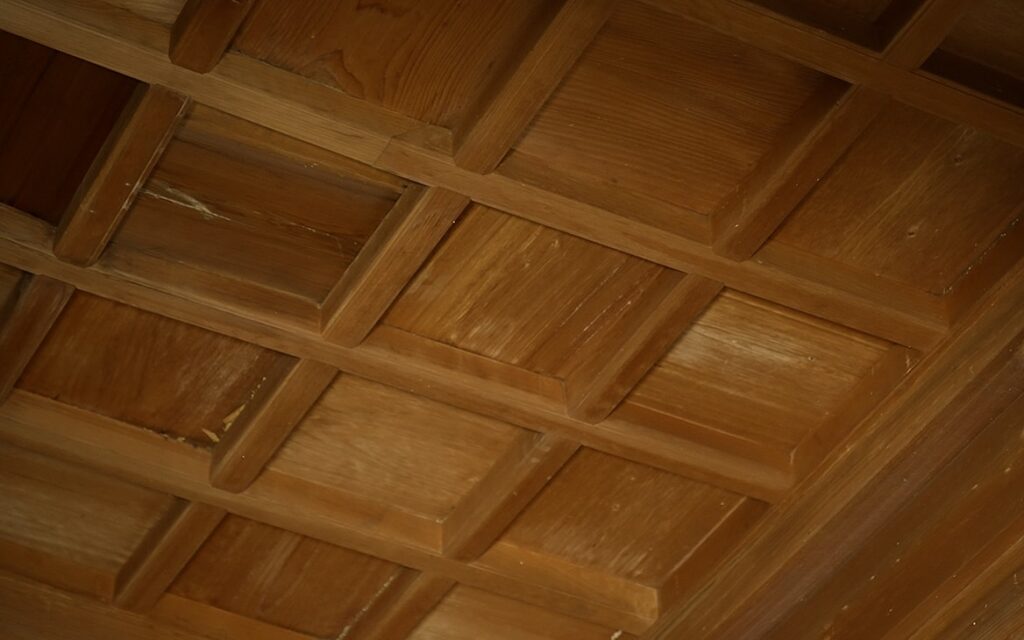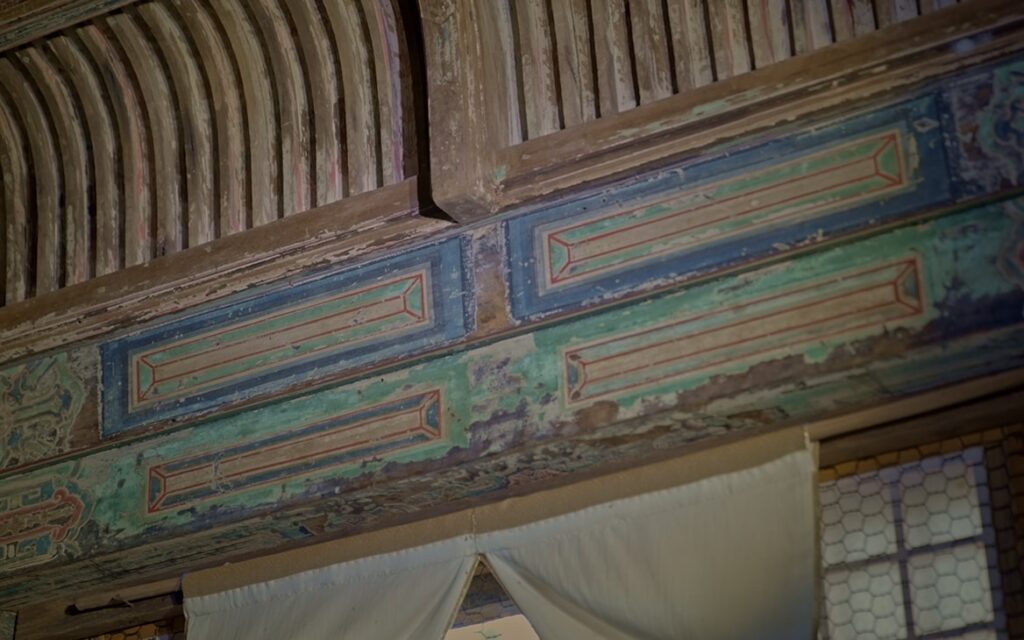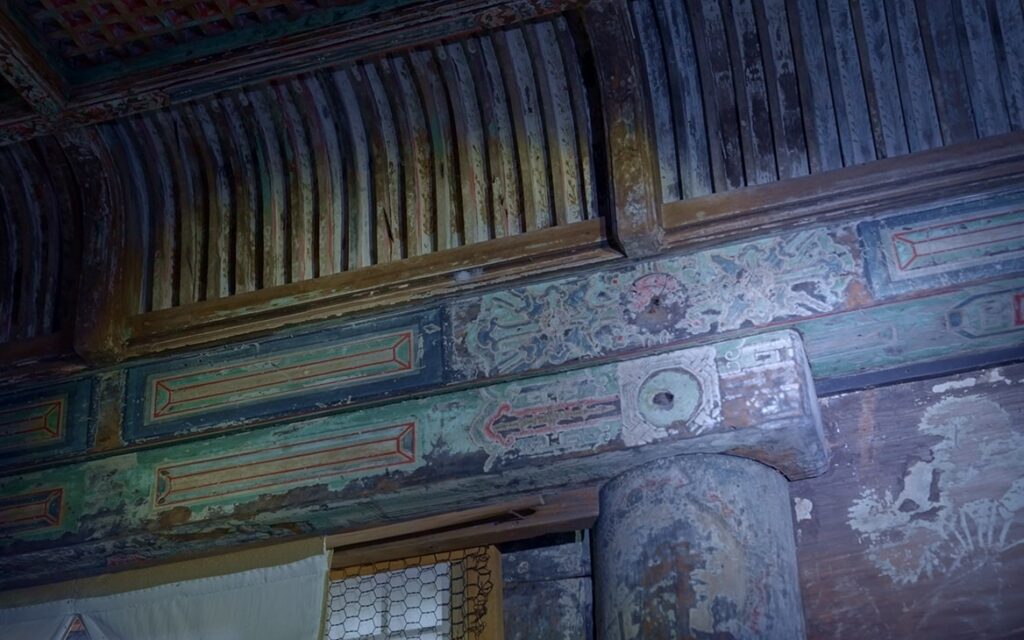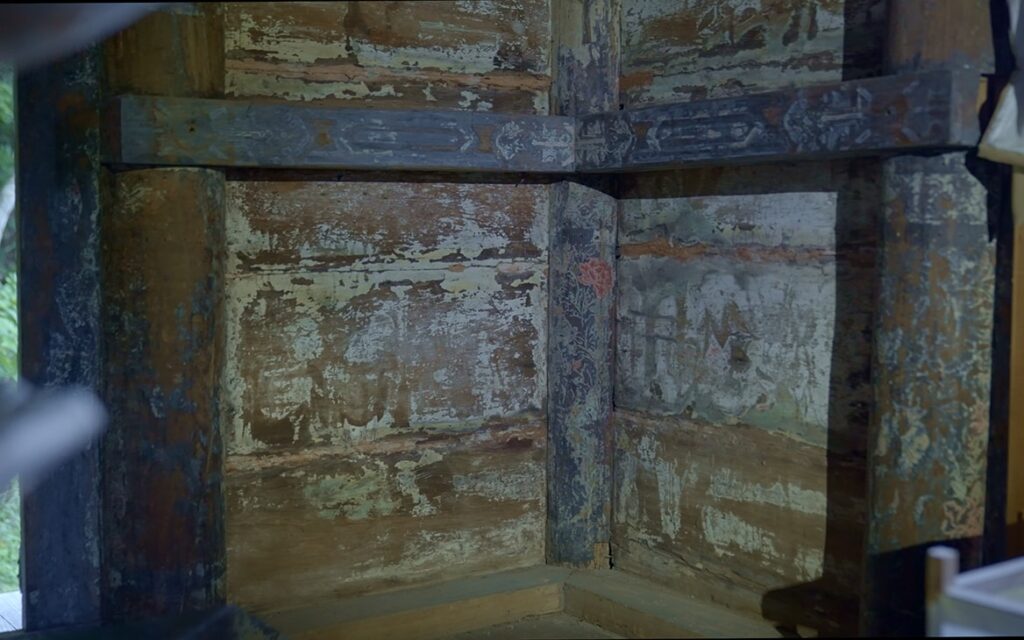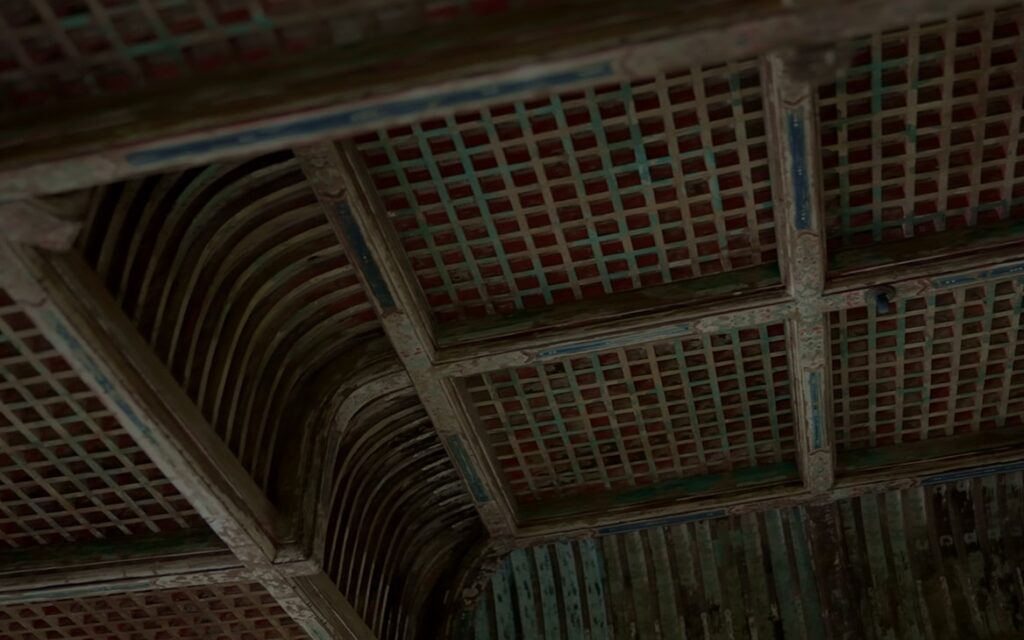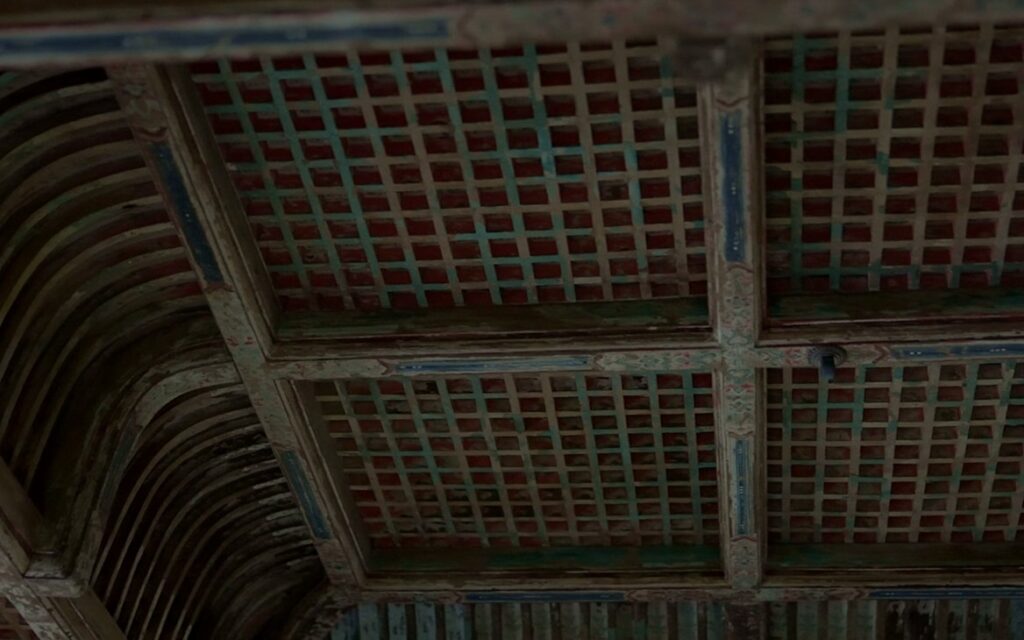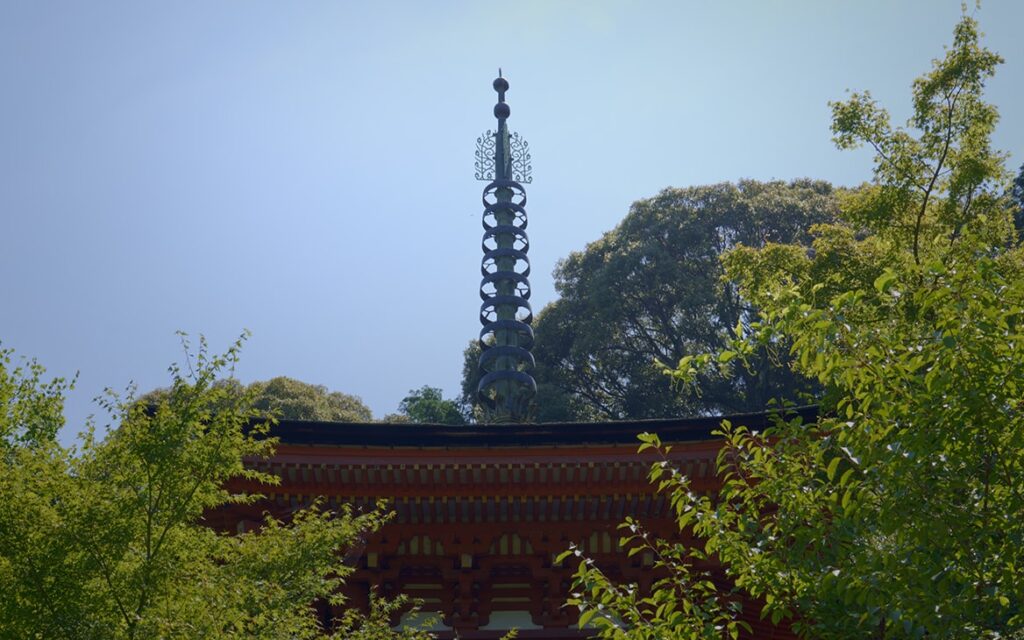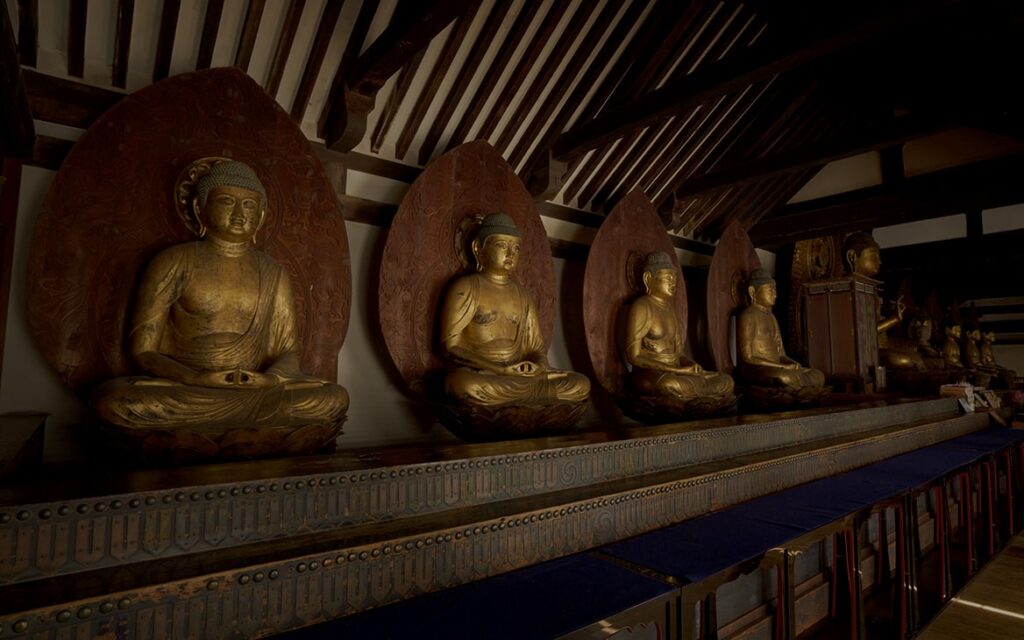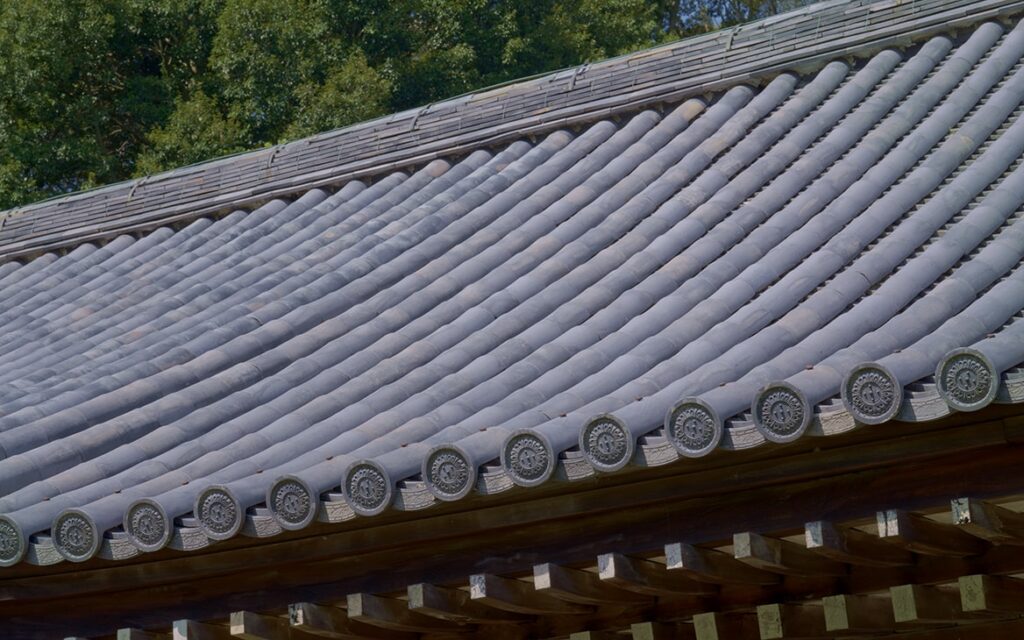National Treasure (Tresures)Main Hall
- Late Heian period
- Eleven-Bay Long Structure / Four-Bay Transverse Span / Single Tier / Square Building with Hipped Roof / One-Bay Pent Roof / Tiled Roof (hongawarabuki)
Main Hall
Audio Guide Playing
Note: Please use the audio guide with headphones and be careful not to disturb others.
Close
The current Main Hall of Joruriji Temple is a National Treasure of Japan. Completed in 1107 and moved to its present location in 1157, it is a well-preserved example of Buddhist architecture from the Heian period (794–1185). It is also appropriately situated on the west shore of the temple’s central pond, to represent its connection to the Amida Nyorai, the Lord of the Western Paradise, enshrined within.
There are nine wooden consecrated statues of the Buddha Amida (Amida Nyorai) enshrined in the Main Hall, lined up behind the hall’s nine sliding doors. Amida Nyorai is called the Lord of the Western Paradise. This deity is often called upon to lead the souls of the dead to the world beyond this one. According to historical records, during the twelfth century, many temples with groups of nine Amida Nyorai were built at the request of the imperial family or court nobles. However, Joruriji Temple is believed to be the only remaining example of those temples. The line of nine statues represents nine manifestations of Amida Nyorai corresponding to the nine patterns of human rebirth.
It is believed that the central Amida Nyorai within the Main Hall, the largest, was the first to be created and was carved in the late eleventh century. The other eight would then have followed shortly after in the early twelfth century. The statues show various differences in expression, as well as variety in the motifs on the halos behind their heads. These statues were built using yosegizukuri, or joined woodblock technique, and they are hollow on the inside. When the largest statue underwent restoration work, woodblock prints of Amida Nyorai were discovered inside the Amida statue, thought to have been there since the statue’s creation.
Other Cultural Heritage
-
National Treasure (Tresures)
Main Hall
-
National Treasure (Tresures)
Three-Storied Pagoda
-
Important Cultural Property
Stone Lantern at base of Three-Storied Pagoda
-
Important Cultural Property
Stone Lantern in front of Main Hall
-
Historic Site, Place of Scenic Beauty, Natural Monument
Joruriji Temple Garden
Sacred Site: MinamiyamashiroTono-no-sato
Joruriji Temple is located in the hilly region at the border of Kyoto Prefecture and Nara Prefecture. Historically, this area was a sacred site where monks from great temples in Nara, such as Kofukuji and Todaiji, would retreat from the world for self-cultivation and study. It is said that the name "Tono" derives from the area's ancient scenery, when three-storied pagodas, thirteen-tiered stone pagodas, and Gorinto pagodas clustered across the landscape forming the appearance of a mountain ridge, so that the place was referred to as the Ridge of Pagodas, or tono. Tono remains a historically rich area today, with the remains of Zuiganji Temple and numerous stone Buddhist statues dotted around scenic villages and the surrounding fields, forests, and mountains.

Zuigan-ji Temple
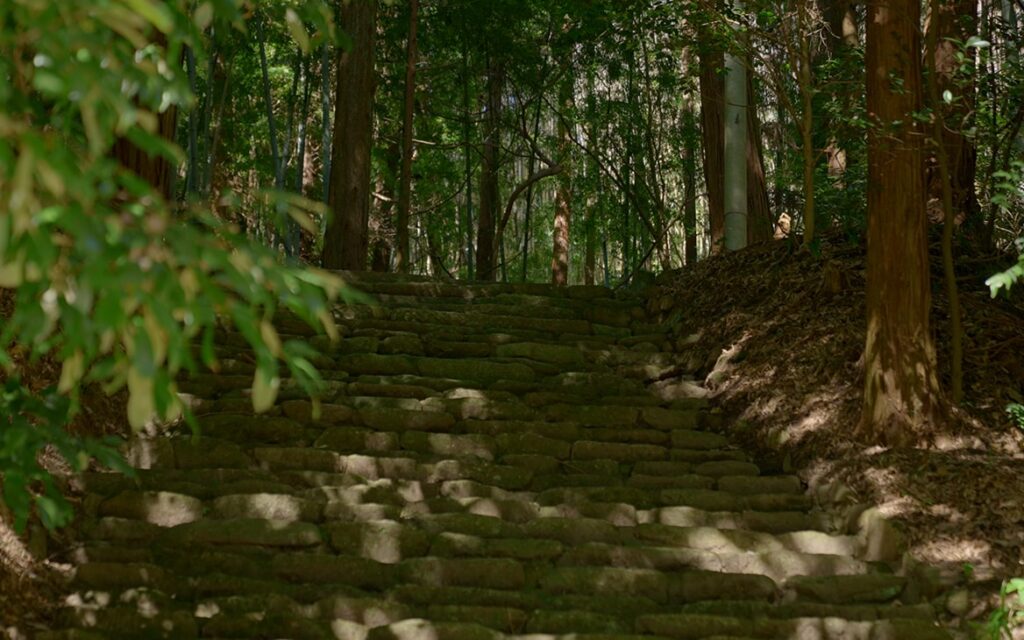
A branch temple of Kofukuji, it was destroyed by fire during the Kamakura period (1185–1333). It was later revived as a small temple but was abolished in the early Meiji era (1868–1912).
Cultural Heritage Featuring This Term
Close
Nanto
Current-day Nara City.
Cultural Heritage Featuring This Term
Close
Todai-ji
Founded in the early 8th century by Emperor Shomu, this temple serves as the head temple of the Kegon sect. The principal image is the Vairocana Buddha, commonly known as the Great Buddha of Nara, and its Great Buddha Hall is one of the largest wooden structures in the world.
Cultural Heritage Featuring This Term
Close
Pure Land
The Pure Land of Amida. It is an ideal world of ease and bliss, free from suffering, said to lie beyond ten trillion lands to the west.
Cultural Heritage Featuring This Term
Close
White Path towards the Paradise between Two Rivers of Rage and Greed
A metaphor for the faith in attaining rebirth in paradise according to Pure Land Buddhism, as described by the monk Shandao. This metaphor was primarily depicted on hanging scrolls used for sermons. The voice of Shakyamuni from the eastern bank saying "Go" and a call of Amitabha from the western bank saying "Come" could be heard. Responding to these calls, a person traverses the white path, arriving at the western bank to achieve rebirth in the blissful world of enlightenment known as the Pure Land.
Cultural Heritage Featuring This Term
Close
Pure Land garden
A garden form produced between the Heian and Kamakura periods. It was greatly influenced by Pure Land Buddhism. Since it aims to recreate the Amida's Pure Land, it features a garden pond stretching in front of temple buildings. It is classified as a natural landscape garden alongside shinden and shoin-zukuri gardens.
Cultural Heritage Featuring This Term
Close
washbasin
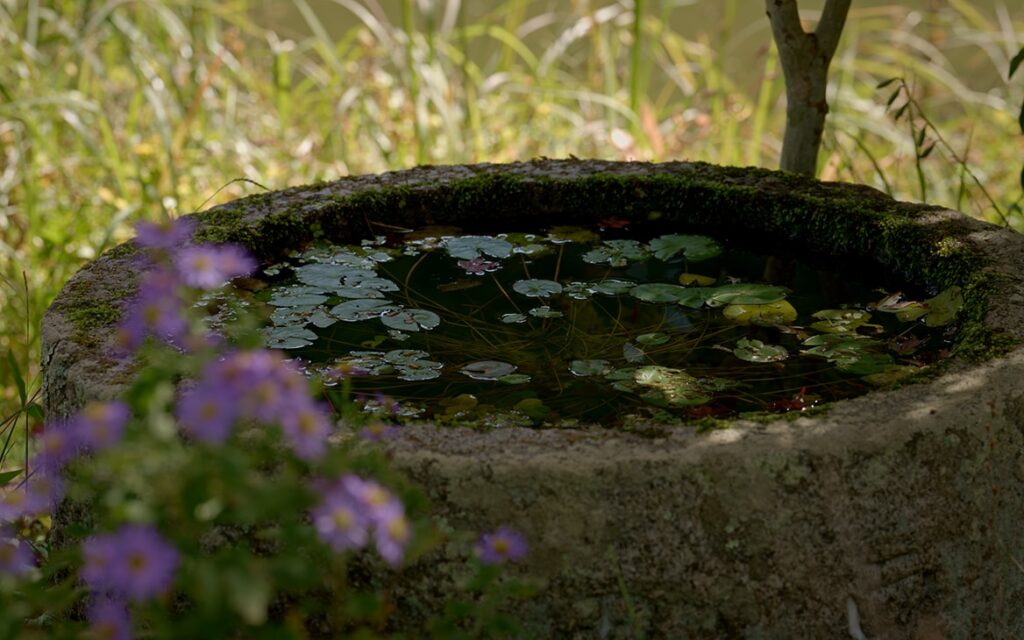
A vessel or basin used for holding water for the purpose of washing hands. It is utilized to ensure water is available for cleansing the mouth and purifying the body in front of Shinto shrines or Buddhist altars.
Cultural Heritage Featuring This Term
Close
rocky coastal scenery
One of the expressions of coastal scenery in temple gardens.
Cultural Heritage Featuring This Term
Close
tower gate
A two-storied gate. There is a roof only on the second floor, but no roof on the first floor. Instead, koshigumi (interlocking wooden bracket sets) are formed around the perimeter.
Cultural Heritage Featuring This Term
Close
hogen
A rank within the monastic hierarchy, considered intermediate among the ranks of hoin, hogen, and hokkyo.
Cultural Heritage Featuring This Term
Close
tutelary deity
A deity that protects land and buildings from calamity. Originally, this deity was enshrined as a guardian of Buddhist temples.
Cultural Heritage Featuring This Term
Close
Kasuga
The belief in the Kasuga deity, with Kasuga Taisha Shrine (located in Nara City) as its main shrine.
Cultural Heritage Featuring This Term
Close
Hakusan
A mountain worship tradition that sanctifies the Hakusan mountain range, which spans the three prefectures of Ishikawa, Fukui, and Gifu. This belief system venerates the Hakusan Sansho Gongen, representing a synthesis of Shinto and Buddhist practices.
Cultural Heritage Featuring This Term
Close
Amitabha
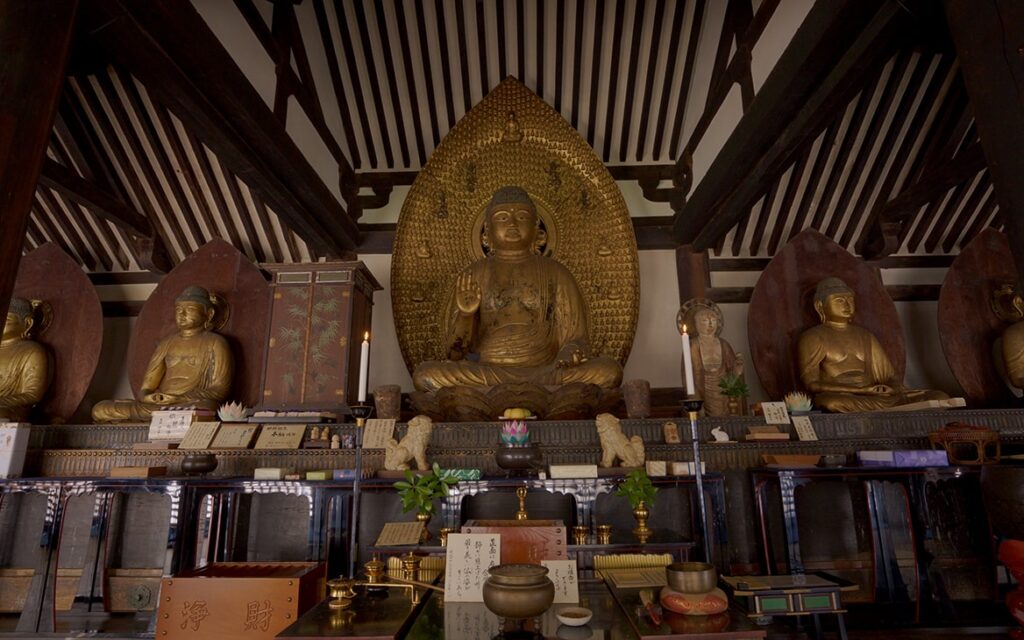
The lord of the Western Pure Land, dedicated to eradicating all forms of suffering and doubt, fulfilling the wishes of all beings.
Cultural Heritage Featuring This Term
Close
central island (nakanoshima)
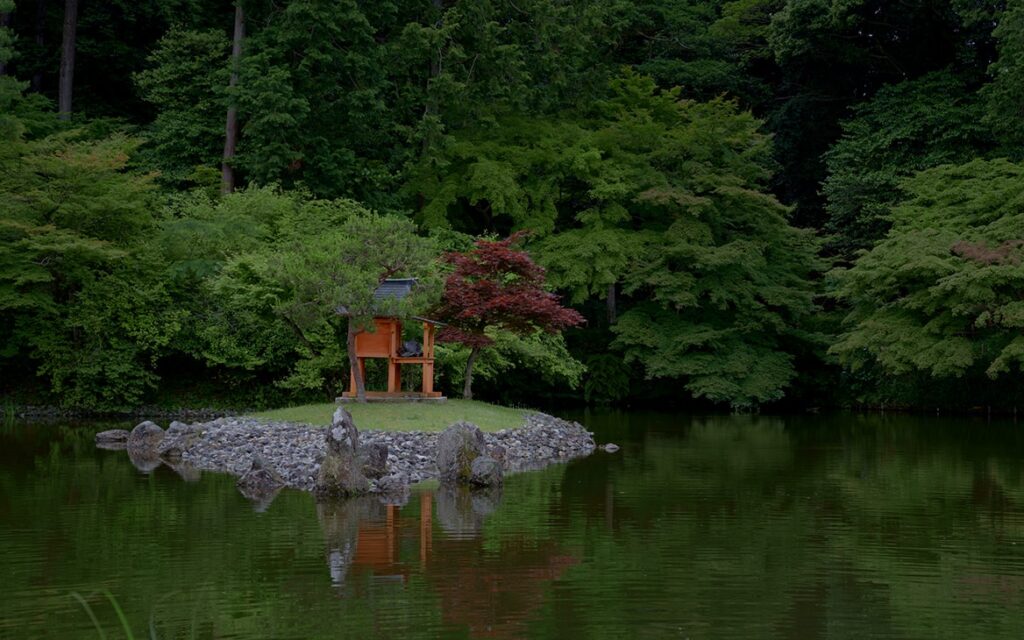
Located between the Eastern Yakushi Paradise and the Amida Paradise, it represents the present world.
Cultural Heritage Featuring This Term
Close
landscaping stones
Stones strategically placed throughout the garden to enhance its scenic charm.
Cultural Heritage Featuring This Term
Close
Ichijo-in
興福寺の門跡 寺院。天禄年間(970〜973)創建。大乗院と交互に興福寺別当を務めた。明治維新により廃寺。
Cultural Heritage Featuring This Term
Close
Eshin
The son of Fujiwara no Tadamichi, he initially entered Ichijo-in and took the name Kakukei. In 1139, at the age of 26, he was appointed as abott of Kofukuji Temple. However, dissatisfied with Kakusei, the son of Fujiwara no Munetada, being appointed in his place, he secluded himself at Narukawayama Temple. He later moved near Joruriji Temple in Odawara, Tono.
Cultural Heritage Featuring This Term
Close
abbot (betto)
Originally used to refer to a high-ranking official position (betto) within the Ritsuryo system, the term later came to designate monks who served as administrators overseeing temple affairs in major temples such as Todai-ji, Kofuku-ji, and Shitenno-ji.
Cultural Heritage Featuring This Term
Close
Kofuku-ji Temple
This temple, located in Nara City, serves as the head temple of the Hosso sect. Its origins date back to the establishment of a predecessor temple in 669. It was founded in conjunction with the relocation of the capital to Heijo (present day Nara) in 710. As a family temple of the Fujiwara clan, it expanded its influence alongside the clan's development. The temple holds numerous national treasures and important cultural properties and is recognized as a World Heritage Site.
Cultural Heritage Featuring This Term
Close
garden pond
The pond that extends in front of a main hall, which enshrines the Amida Buddha. Also referred to as the Treasure Pond.
Cultural Heritage Featuring This Term
Close
Shui Miyako Meisho Zue (Supplemental Pictorial Guide to Scenic Spots in Kyoto)
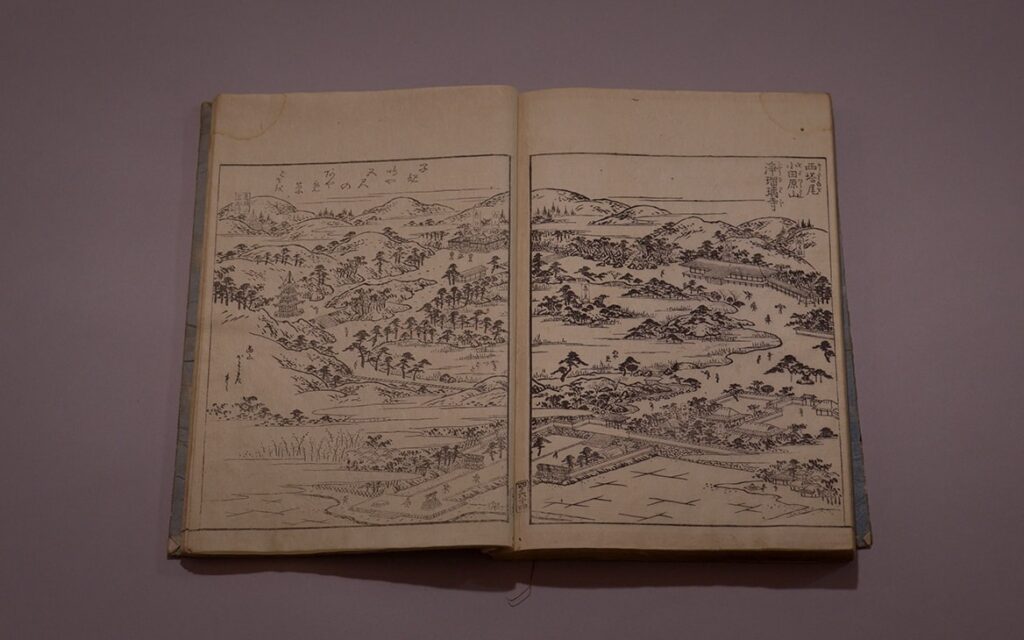
A guide to scenic areas in Kyoto. Published in 1787. It consists of five volumes printed in ink. It is a sequel to the Miyako Meisho Zue published in 1780.
Cultural Heritage Featuring This Term
Close
Edo period
The name of the period that lasted approximately 260 years from when Tokugawa Ieyasu founded the Edo shogunate in 1603 after winning the Battle of Sekigahara in 1600 until the restoration of imperial rule by Tokugawa Yoshinobu in 1867. Also called the Tokugawa period.
Cultural Heritage Featuring This Term
Close
Stone lantern under the three-storied pagoda
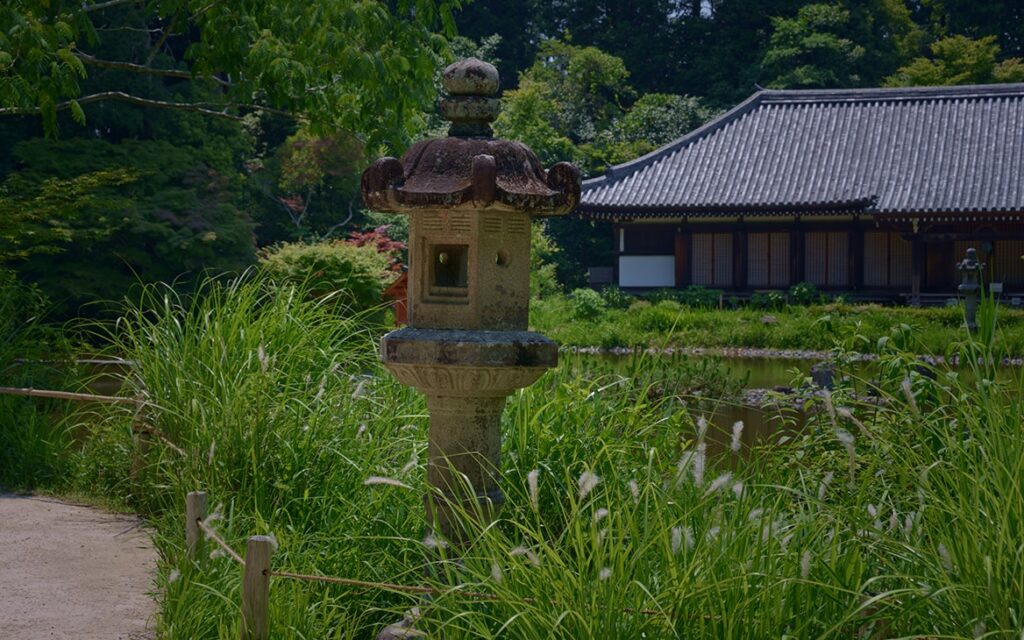
Cultural Heritage Featuring This Term
Close
Nanbokucho period
Also known as the ‘Northern and Southern Courts Period’. It refers to a sequence of events following the collapse of the Kamakura Shogunate and the attempt to restore imperial power by Emperor Go-Daigo, from 1331. Conflicts between supporters of the imperial family and the Ashikaga shogunate led to the establishment of a Northern Court by Ashikaga Takauji, who endorsed Emperor Komyo from the Jimyoin line. This action led to Emperor Go-Daigo establishing the Southern Court in Yoshino. It was a period marked by conflicts between the two courts, before the Northern and Southern Courts were eventually reconciled in 1392.
Cultural Heritage Featuring This Term
Close
restoration marks
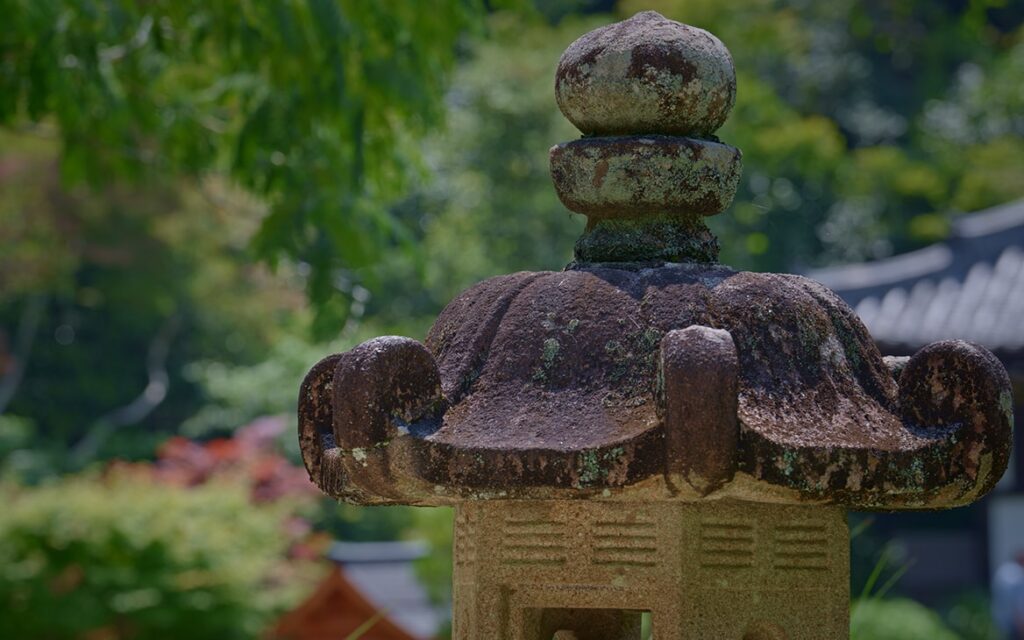
Cultural Heritage Featuring This Term
Close
kozama
Wood that is hollowed out with a carving blade to decorate the side of the podium of the shumidan dais.
Cultural Heritage Featuring This Term
Close
lotus petals

Cultural Heritage Featuring This Term
Close
Stone lantern in front of the main hall

Cultural Heritage Featuring This Term
Close
decorative finial

In Japan, the decorative finial is often represented as a pointed spherical shape, known as a jewel, that has the power to ward off calamities and grant wishes.
Cultural Heritage Featuring This Term
Close
cap

The roof section of stone towers and lanterns.
Cultural Heritage Featuring This Term
Close
light compartment
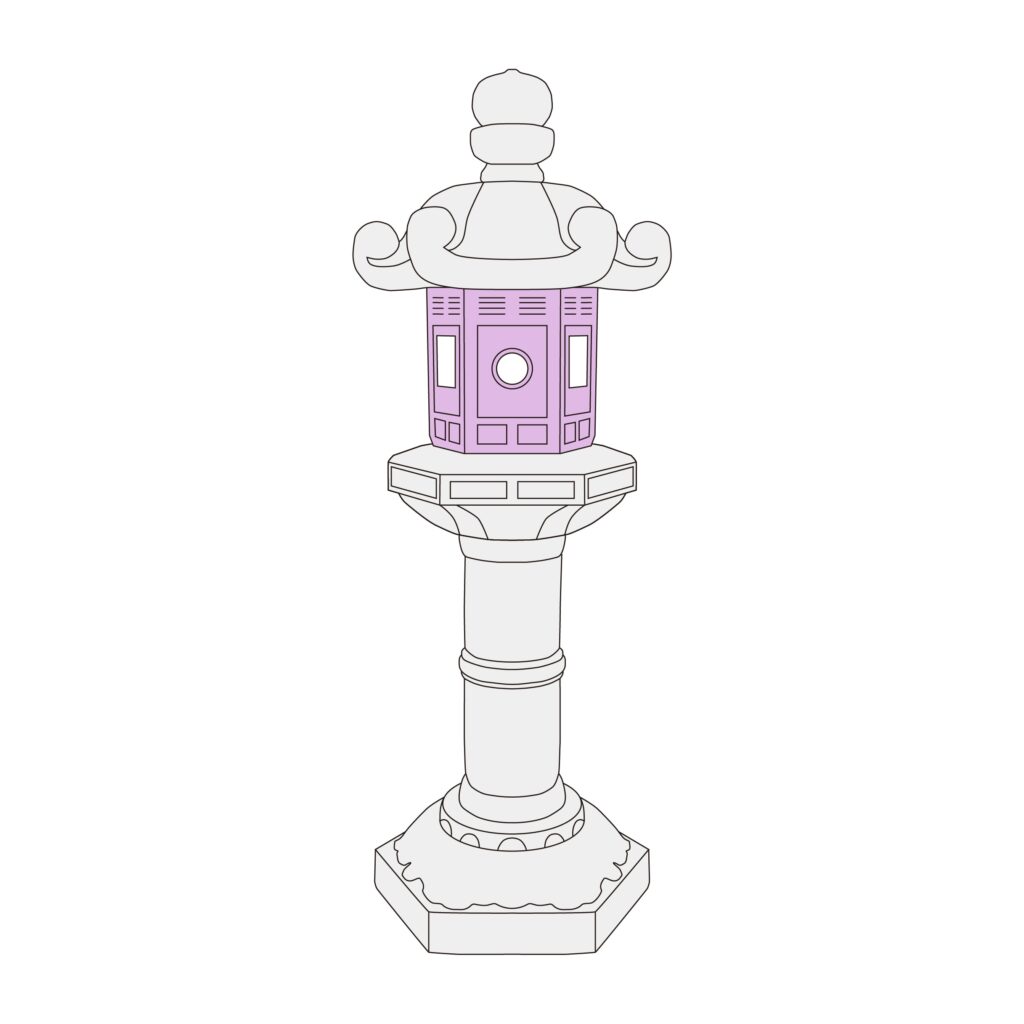
The section where the light source is placed and illuminated.
Cultural Heritage Featuring This Term
Close
middle platform

Part of the stone lantern. It is the platform situated atop the shaft, on which the light compartment is placed. The underside features carved lotus petals, and the upper end is tiered. Kozama engravings may also be etched above the lotus petals.
Cultural Heritage Featuring This Term
Close
shaft
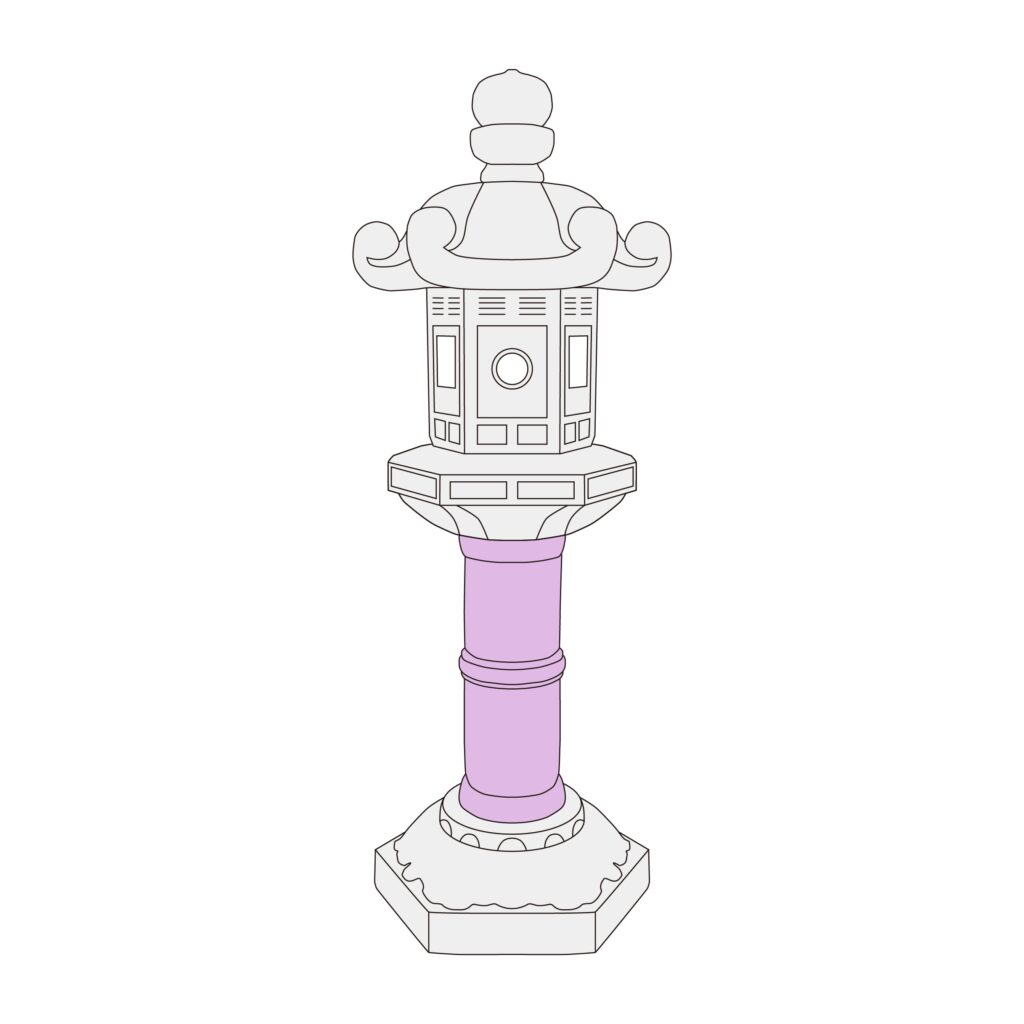
A column-shaped stone that stands on the foundation of a stone lantern and supports the upper parts, including the light compartment, cap, and decorative finial.
Cultural Heritage Featuring This Term
Close
foundation
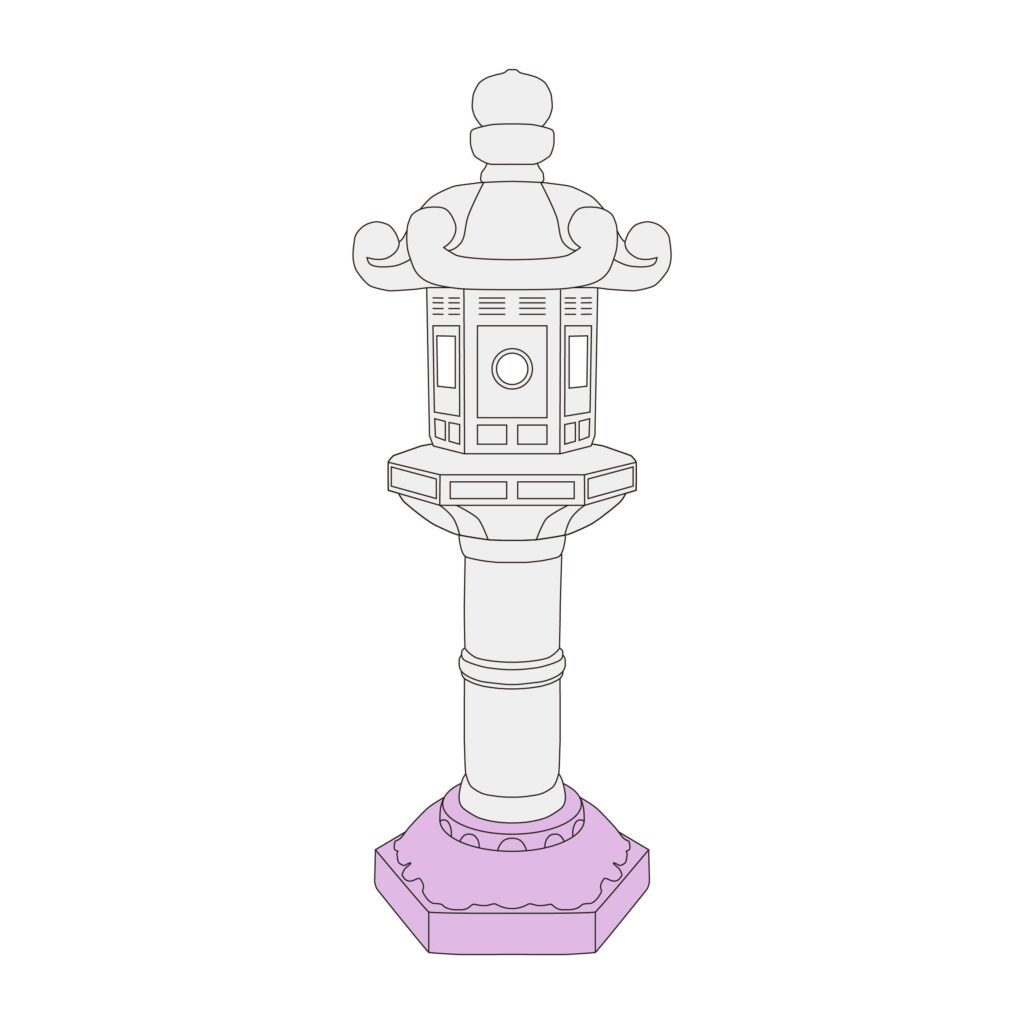
The cut stone at the very bottom of the structure.
Cultural Heritage Featuring This Term
Close
base
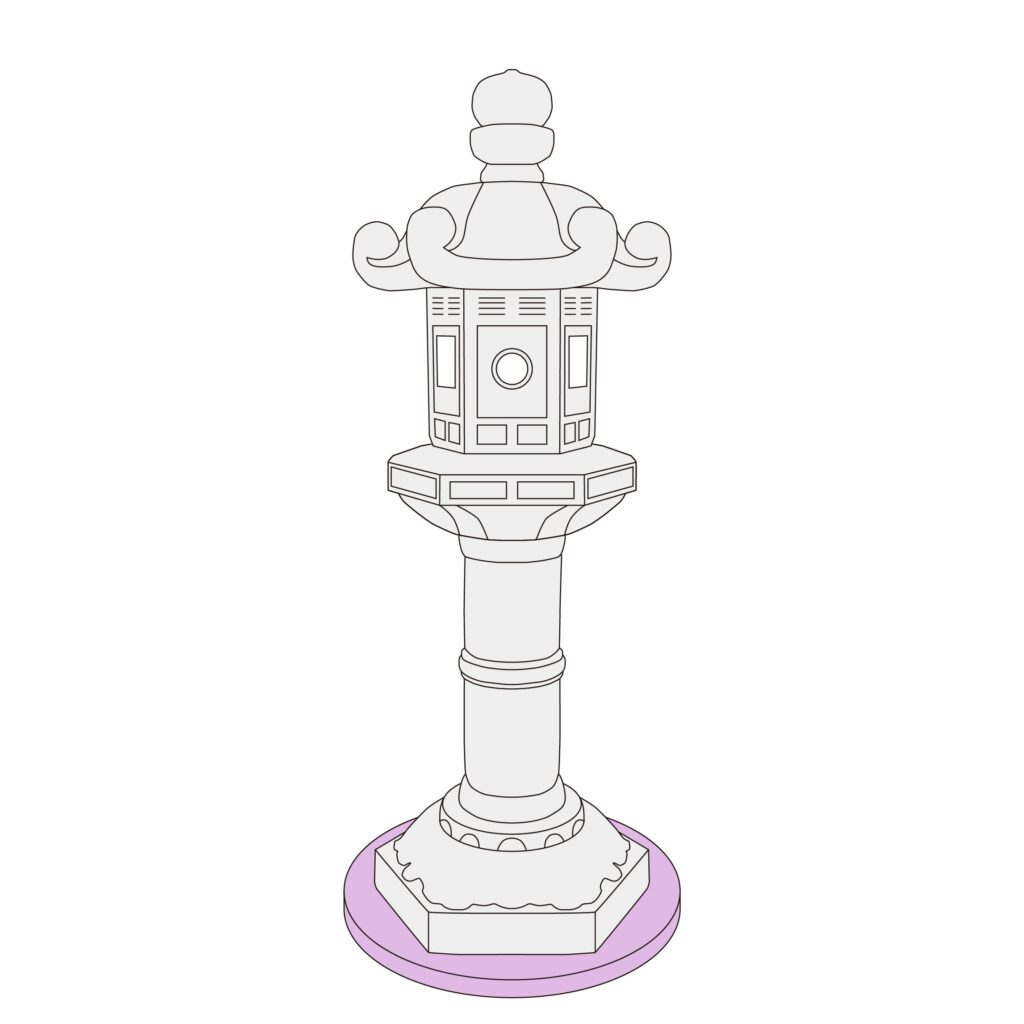
A component of traditional stone-foundation architecture that transfers the building's load to the ground.
Cultural Heritage Featuring This Term
Close
Kasuga lantern
A type of lantern featuring a circular shaft with a light compartment in a flat hexagonal shape.
Cultural Heritage Featuring This Term
Close
granite
Crystalline stone. Known for its hardness, beauty, and durability, it is widely used as a building material.
Cultural Heritage Featuring This Term
Close
Statue of Yakushi Nyorai

Dating from the Heian Period (794-1185), this statue is the hidden principal image of the three-storied pagoda. It has been designated as an important cultural property.
Cultural Heritage Featuring This Term
Close
Kamakura period
The name of the period that lasted for approximately 150 years from when Minamoto no Yoritomo founded the shogunate in Kamakura until Hojo Takatoki’s death in 1333.
Cultural Heritage Featuring This Term
Close
Heian period
The Heian period lasted for approximately 400 years between the transfer of the capital by Emperor Kanmu in 794 and the foundation of the Kamakura Shogunate in 1185, and the central administration was in Heian-kyo (present-day Kyoto). Generally, the period is divided into three sections: the Early, Mid- and Late Heian periods. In other words, the period of reviving the political system based on Ritsuryo codes, the regency period and the Insei period (governed by a retired emperor), respectively. (The end of the Late Heian period was ruled by the Taira clan.) Also called the period of Heian imperial court.
Cultural Heritage Featuring This Term
Close
pent roof

In shrine and temple architecture, a structure with a roof that protrudes over the front steps. It allows the priest and worshippers to conduct ceremonies or pay respects from the front of the hall.
Cultural Heritage Featuring This Term
Close
Amida Nyorai
The guiding Buddha of the Pure Land to the West. Renowned among all Buddhas for possessing the most radiant light, this nyorai is believed to save even the most heavy of sinners.
Cultural Heritage Featuring This Term
Close

